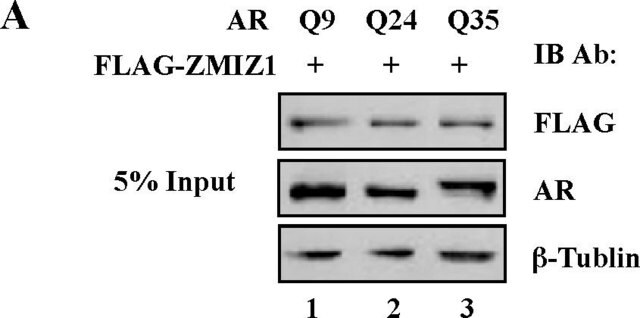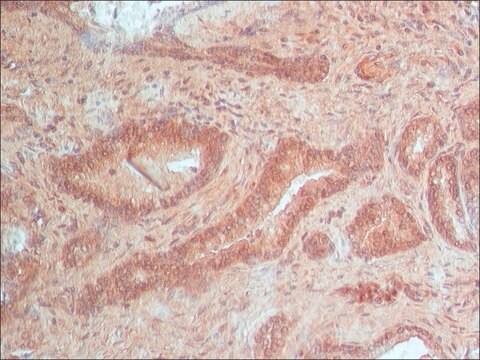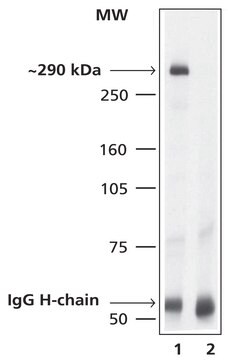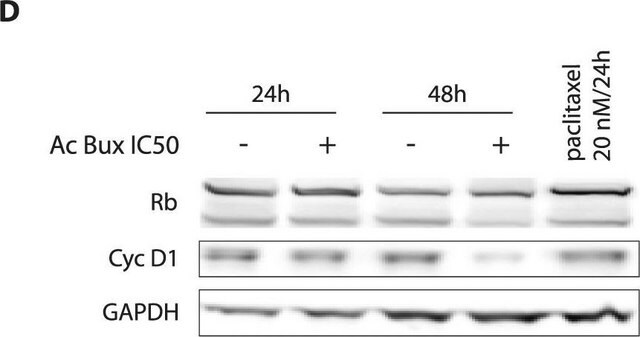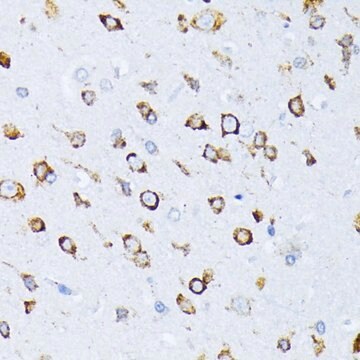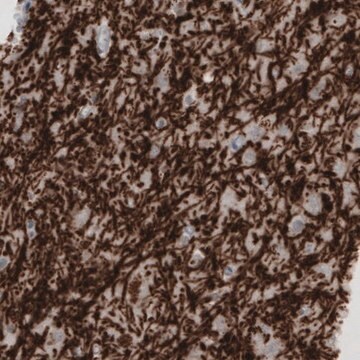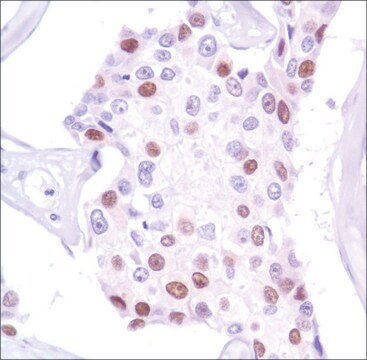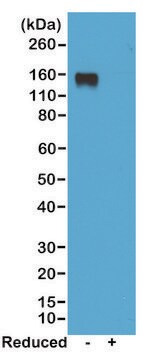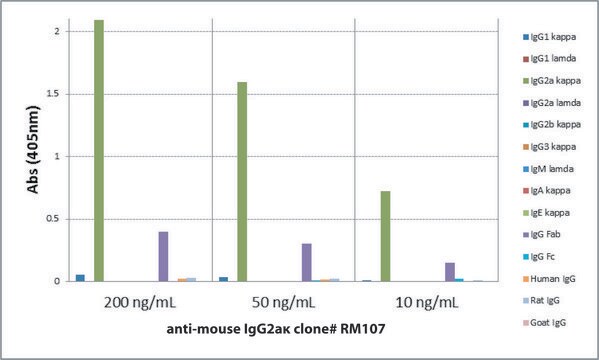SAB5500165
Anti-Progesterone Receptor antibody, Rabbit monoclonal
recombinant, expressed in proprietary host, clone SP2, tissue culture supernatant
Anmeldenzur Ansicht organisationsspezifischer und vertraglich vereinbarter Preise
Alle Fotos(1)
About This Item
UNSPSC-Code:
12352203
NACRES:
NA.41
Empfohlene Produkte
Biologische Quelle
rabbit
Qualitätsniveau
Rekombinant
expressed in proprietary host
Konjugat
unconjugated
Antikörperform
tissue culture supernatant
Antikörper-Produkttyp
primary antibodies
Klon
SP2, monoclonal
Speziesreaktivität
human (tested)
Speziesreaktivität (Voraussage durch Homologie)
bovine, rabbit, pig
Methode(n)
immunohistochemistry: 1:400
Isotyp
IgG
UniProt-Hinterlegungsnummer
Versandbedingung
wet ice
Lagertemp.
2-8°C
Posttranslationale Modifikation Target
unmodified
Angaben zum Gen
human ... PGR(5241)
Allgemeine Beschreibung
The progesterone receptor (PgR) is an estrogen-regulated protein. It has been proposed that expression of PgR determination indicates a responsive estrogen receptor (ER) pathway. A number of studies have shown that PgR determination provides supplementary information to ER.
Progesterone receptor (PGR) belongs to the steroid/thyroid hormone receptor family of ligand-activated transcription factors. It possesses the amino-terminal AF1 region, the central DNA-binding domain (DBD) and the carboxyl-terminal ligand- binding domain (LBD). The PGR gene is localized on human chromosome 11q22.1.
Progesterone receptor (PGR) belongs to the steroid/thyroid hormone receptor family of ligand-activated transcription factors. It possesses the amino-terminal AF1 region, the central DNA-binding domain (DBD) and the carboxyl-terminal ligand- binding domain (LBD). The PGR gene is localized on human chromosome 11q22.1.
Immunogen
Recombinant protein encoding aa 412-526 of human progesterone receptor.
Biochem./physiol. Wirkung
Progesterone receptor (PGR) functions as a transcription factor,
which modulates the transcription of target genes in response to progesterone and other hormones. It is phosphorylated on multiple sites and at times, the phosphorylation changes according to the hormone involved. During hormone unavailability, PGR is bound to heat shock proteins. When the ligand binds, it causes the release of PGR from heat shock proteins. It is then translocated to the nucleus, where it binds to its DNA response elements (SREs) and to the components of the transcription machinery. PGR also binds to chromatin templates and results in chromatin remodeling adjacent to the PGR-binding sites.
which modulates the transcription of target genes in response to progesterone and other hormones. It is phosphorylated on multiple sites and at times, the phosphorylation changes according to the hormone involved. During hormone unavailability, PGR is bound to heat shock proteins. When the ligand binds, it causes the release of PGR from heat shock proteins. It is then translocated to the nucleus, where it binds to its DNA response elements (SREs) and to the components of the transcription machinery. PGR also binds to chromatin templates and results in chromatin remodeling adjacent to the PGR-binding sites.
Leistungsmerkmale und Vorteile
Evaluate our antibodies with complete peace of mind. If the antibody does not perform in your application, we will issue a full credit or replacement antibody. Learn more.
Physikalische Form
0.1 ml rabbit monoclonal antibody supplied as tissue culture supernatant in TBS/1% BSA buffer pH 7.5 with less than 0.1% sodium azide.
Haftungsausschluss
Unless otherwise stated in our catalog or other company documentation accompanying the product(s), our products are intended for research use only and are not to be used for any other purpose, which includes but is not limited to, unauthorized commercial uses, in vitro diagnostic uses, ex vivo or in vivo therapeutic uses or any type of consumption or application to humans or animals.
Sie haben nicht das passende Produkt gefunden?
Probieren Sie unser Produkt-Auswahlhilfe. aus.
Lagerklassenschlüssel
10 - Combustible liquids
WGK
WGK 2
Flammpunkt (°F)
Not applicable
Flammpunkt (°C)
Not applicable
Hier finden Sie alle aktuellen Versionen:
Besitzen Sie dieses Produkt bereits?
In der Dokumentenbibliothek finden Sie die Dokumentation zu den Produkten, die Sie kürzlich erworben haben.
Jake J Reske et al.
Human molecular genetics, 29(20), 3412-3430 (2020-10-20)
Although ARID1A mutations are a hallmark feature, mutations in other SWI/SNF (SWItch/Sucrose Non-Fermentable) chromatin remodeling subunits are also observed in endometrial neoplasms. Here, we interrogated the roles of Brahma/SWI2-related gene 1 (BRG1, SMARCA4), the SWI/SNF catalytic subunit, in the endometrial
Steroid receptor coactivator-1 (SRC-1) enhances ligand-dependent and receptor-dependent cell-free transcription of chromatin.
Liu Z, et al.
Proceedings of the National Academy of Sciences of the USA, 96(17), 9485-9490 (1999)
Olivia Jeong et al.
International journal of molecular sciences, 23(23) (2022-12-12)
Women with complex atypical hyperplasia (CAH) or early-stage endometrioid endometrial cancer (EEC) are candidates for fertility preservation. The most common approach is progesterone (P4) therapy and deferral of hysterectomy until after completion of childbearing. However, P4 therapy response rates vary
Phosphorylation of human progesterone receptor by cyclin-dependent kinase 2 on three sites that are authentic basal phosphorylation sites in vivo.
Zhang Y, et al.
Molecular Endocrinology, 11(6), 823-832 (1997)
Phosphorylation of human progesterone receptor by cyclin-dependent kinase 2 on three sites that are authentic basal phosphorylation sites in vivo.
Y Zhang
Molecular Endocrinology, 11(6), 823-832 (1997)
Unser Team von Wissenschaftlern verfügt über Erfahrung in allen Forschungsbereichen einschließlich Life Science, Materialwissenschaften, chemischer Synthese, Chromatographie, Analytik und vielen mehr..
Setzen Sie sich mit dem technischen Dienst in Verbindung.